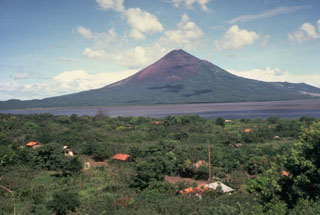Report on Momotombo (Nicaragua) — September 1993
Bulletin of the Global Volcanism Network, vol. 18, no. 9 (September 1993)
Managing Editor: Edward Venzke.
Momotombo (Nicaragua) Strong fumarolic activity but temperatures decline
Please cite this report as:
Global Volcanism Program, 1993. Report on Momotombo (Nicaragua) (Venzke, E., ed.). Bulletin of the Global Volcanism Network, 18:9. Smithsonian Institution. https://doi.org/10.5479/si.GVP.BGVN199309-344090
Momotombo
Nicaragua
12.423°N, 86.539°W; summit elev. 1270 m
All times are local (unless otherwise noted)
Fumarolic activity in the crater remained strong and a large steam plume was observed continuously during the first week of September. Temperatures measured during a crater visit on 6 September ranged from 200-604°C. Fumarole temperatures are 100-300°C cooler that those reported in the 1980's. Native sulfur deposits were associated with low-to-moderate temperature fumaroles, while cavities of high-temperature vents were lined with a black mineral tentatively identified as magnetite. A strong SO2 odor permeated the air.
The trail to the crater had been cut by numerous rock avalanches during the past 18 months. Avalanche chutes, measuring tens of meters across and several meters deep, were most prominent near the summit, E of where the trail enters the crater. The crater can still be accessed by scrambling across these chutes, but there exists a strong potential for further avalanches of pyroclastic breccias from above. Nearby residents have recently reported deep rumblings from the volcano.
Geological Summary. Momotombo is a young stratovolcano that rises prominently above the NW shore of Lake Managua, forming one of Nicaragua's most familiar landmarks. Momotombo began growing about 4500 years ago at the SE end of the Marrabios Range and consists of a somma from an older edifice that is surmounted by a symmetrical younger cone with a 150 x 250 m wide summit crater. Young lava flows extend down the NW flank into the 4-km-wide Monte Galán caldera. The youthful cone of Momotombito forms an island offshore in Lake Managua. Momotombo has a long record of Strombolian eruptions, punctuated by occasional stronger explosive activity. The latest eruption, in 1905, produced a lava flow that traveled from the summit to the lower NE base. A small black plume was seen above the crater after a 10 April 1996 earthquake, but later observations noted no significant changes in the crater. A major geothermal field is located on the south flank.
Information Contacts: Michael Conway and Andrew Macfarlane, FIU; Charles Connor, Southwest Research Institute; Oscar Leonel Urbina and Cristian Lugo, INETER.

